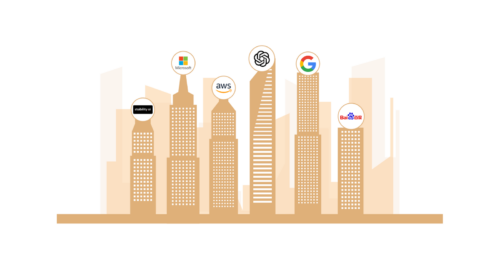Night at the AI Museum

You walk into a hushed room full of unfamiliar things. A few other people are milling around quietly, gazing at the images on the walls and the objects on the pedestals. You imitate them, floating around slowly as you try to understand what you’re looking at. You squint at the little text on the wall that tells you names, dates, and materials, but you’re still unsure what it all means. So you just drift through the room for a few minutes—enough to make it seem like you appreciated the exhibit—and then move on.
Countless museum and gallery-goers have this deeply unsatisfying experience every day, and there’s no telling how many people choose not to visit museums precisely because this is what they expect. The words on the walls only provide a tiny sliver of the context around the item on display, usually not enough to make it meaningful to the average person. The situation is even more challenging for those who struggle to see and comprehend those words.
To make an exhibit truly engaging requires storytelling. Experts use stories to bring objects to life—for example, as the BBC did with the radio series A History of the World in 100 Objects. Each object became an entry point into a story about humanity, art, and culture.
Museums have tried to make storytelling scalable through audio tours, but this format has limitations. Typically, the tour contains separate segments for each item, so the narrative of the whole exhibition doesn’t come to life. The interface is often clunky and unintuitive, which distracts from the user’s enjoyment of the exhibit. Plus, audio tours aren’t interactive and don’t adapt to individual users.
AI could be the key to making the museum experience truly engaging for everyone. This technology could give every visitor their own personal tour guide, who doesn’t just spout pre-recorded facts but engages in a conversation tailored to their background, interests, and pace. As creators of both museum experiences and AI experiences, we see huge potential for museums to wow their visitors and attract massive new audiences.
AI is Already on Museums’ Radar
Over the last decade, museums have been exploring many ways of using AI. According to arts & metrics, at least 122 museum-related AI initiatives have been started since 2010. They are taking place in all kinds of institutions around the world, from the British Museum to the Museum of Tomorrow in Brazil.
Many of these initiatives are focused on operations. AI programs have been developed to catalog and describe artifacts, predict visitor levels, optimize building maintenance, answer visitor questions off-site, analyze visitor engagement, and more. Those applications are certainly useful, but we’re interested in natural language AI as a core driver of the visitor experience.
Only a few museums have made forays in this area, and they typically involve one AI interface serving many visitors at once. For example, the Smithsonian Museums created Pepper, a humanoid robot designed to help visitors by telling stories and answering commonly asked questions. The St. Petersburg Dalí Museum launched Dalí Lives, a life-size AI likeness of Salvador Dalí that welcomes visitors to the museum and introduces them to his life and work. The Illinois Holocaust Museum created an interactive 3D hologram of a real Holocaust survivor who can answer up to 2,000 questions about her experiences.
There have also been many efforts to create individualized AI experiences through chatbots and websites. For example, the House Museums of Milan created an AI chatbot through Facebook Messenger that creates a personalized itinerary and guides the user to complete activities. Hello History is an AI-based app that allows users to chat in real-time with historical figures from Sun Tzu to Elvis Presley. Cultural Icons is a Google Lab Experiment where users can test their knowledge and ask questions about important people, places, and ideas throughout history.
Still, none of these projects have quite reached the level of a personal, AI-driven museum tour guide…yet.
AI Tour Guides: A Huge Leap Beyond Audio Tours
With the rapid development of natural language processing, that may soon change. Large language models (like ChatGPT) can be trained on the vast quantities of data museums have about their collections, as well as other published works like papers, books, lectures, and more. A museum’s AI model can learn the full context of the specific items in an exhibit and the broader movements, relationships, and influences around them—much like a human expert, but with the ability to hold and process far more information.
Technology like this promises to be more like a personal tour guide than an audio tour. In theory, it could ask the user about their interests and previous knowledge of the people, places, and events featured in the exhibit. It would choose information the user is likely to find interesting and phrase it in a way that’s relatable and easy to understand. It would draw connections between items as the user moves around the exhibit. It would answer the user’s questions and guide them to and pieces they’re most likely to enjoy. And, of course, it would speak the user’s native language.
Most importantly, the museum experience would revolve around stories and conversations—the ways humans naturally engage with each other—not just information. The goal is to make an AI tour as much like a human-to-human experience as possible, but scalable in a way human tour guides can never be.
Gamifying the Museum Experience with AI
Long before AI arrived on the scene, some museums—especially those oriented toward children—used gamification techniques to engage visitors more deeply. With puzzles, quizzes, scavenger hunts, and other games, they encourage visitors to explore and interact with as much of the museum’s content as possible. It’s very effective when done well because it makes visitors active participants in the exhibit rather than passive observers.
Gamification is possible without AI, but an AI tour guide can make it easier and more intuitive. It can become an integrated part of the exhibit rather than a separate element, where the AI guide automatically provides the appropriate instructions, prompts, questions, or clues based on where the user is. It can track their progress for them, and even turn it into points that can be redeemed for future museum visits or gift shop credits. This takes the burden of figuring out how to play the game off the visitor, so they can focus on playing, learning, and enjoying the exhibit.
Solving the Technical Challenges of Museum AI
All that said, there are some implementation challenges to solve first, the most obvious being the development of the AI model. Current large language models can be amazing, but they sometimes feel robotic or suffer from “hallucinations.” Museums will need to partner with experts like Journey’s AI studio or hire in-house specialists to develop models trained on their collections, which will not deliver inaccurate information or allow inappropriate interactions.
Hardware design and maintenance could also pose significant challenges. The hardware could be similar to what we see today for audio tours—an electronic device with headphones owned by the museum—but it would have to be connected by wifi to central servers that drive the AI model. Alternatively, museums could run the AI tour as an app that visitors access on their smartphones and listen to with their own headphones. One day, tours like these might even use smart glasses, so the AI model can detect what users are looking at and offer information about it.
The costs for both the development and delivery of an AI tour guide pose a significant obstacle. Most museums operate on tight budgets and aren’t able to invest much capital in AI efforts. However, creative funding mechanisms might help these efforts move forward quickly. For example, museums might consider a revenue-sharing model where an AI company creates and operates the guide on their behalf, sharing the revenue after the initial investment has been recouped.
AI Could Transform the Museum Business
If AI tour guides can get close to mimicking a human-to-human conversation, it would revolutionize the museum experience. It would attract more visitors, especially people who wouldn’t normally choose to go to a museum. Visitors would stay longer and engage at a much deeper level, leading to more repeat visits and better reviews. The tour would create a new revenue stream, raising the average ticket value and providing more capital to invest in future exhibitions.
In short, AI could breathe new life into the entire museum business.




 Jules Coke
Jules Coke





